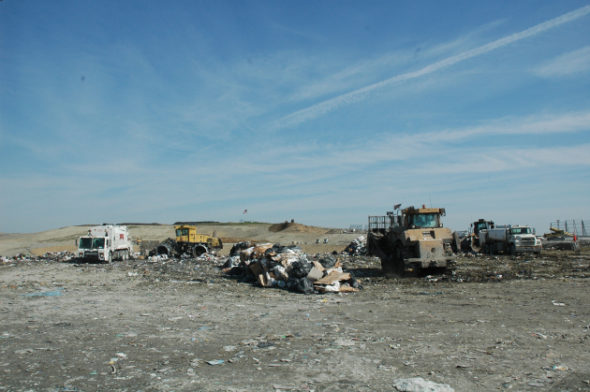

Yarn Registry BLOG: A Landfill is an Ecosystem Unto Itself, part III
- Published: November 12, 2016
Worms, Roaches, “Filth Flies” and other insects
Part 3 of a series investigating the many layers of life in the average landfill. This week’s entry discusses the myriad insects that reside there and how they such an environment work for them. Next week: Birds!
Insects are important to the decomposition of garbage because they eat a lot of trash and tunnel their way through it, which mixes and aerates it. They tear up material into smaller pieces, which is readily eaten by microorganisms. Bacteria often digest their feces. Insects are of course also food for other insects and larger creatures. Rove beetles feed on the maggots of flies, for example, while centipedes often eat worms. Further afield, the garbage grasslands contain the insects one might expect in grassland — grasshoppers, crickets, butterflies.
Some insects find their way to the trash, while some are inadvertently brought to it. Infrequent collection, loose lids, and holey containers are the prime culprits when it comes to infestation from the outside. An estimated 60 percent of city garbage containers are infested with fly larvae; fruit flies can fit through openings a millimeter wide. In another interesting case of filth in reverse, cockroaches are often found in landfills, as they hitch a ride in the belongings humans have discarded. And to make matters more unpleasant, there are mosquitoes. Standing water often found in containers or used rubber tires is an ideal breeding ground.
Insects that eat wood can also carve out a niche in the landfill, given the high percentage of organic material in the dump. Microscopic organisms and termites process the wood into a product more nutritious to other wood-eating insects, such as tree borers and beetles. The presence of termites depends on the relative moisture and nutritional content of wood, which, contrary to cartoons that show termites devouring everything in their path, they are quite selective about. (Good wood is high in both.) Like cockroaches, the presence of wood-eating insects in waste sites likely stems from the introduction of wood already infested more so than independently relocating to it.
In one Calvin and Hobbes strip, Calvin relishes being a fly at a picnic table, much to the chagrin of his parents. “Filth! Pestilence! Contamination!” he says with glee (and accuracy). Flies are a ubiquitous presence in areas with any kind of decay. The whine of thousands of flies generally augurs something gross, which acres of wet, stinky trash certainly is. The common housefly is the most abundant insect in landfills around the world. Flies eat decomposing garbage, sucking up liquid waste and spitting saliva on solid items so they can be digested. Flies lay their eggs in garbage too, and are capable of reproducing up to five times over the course of their life, laying over 100 eggs each time. The emerging maggots burrow into garbage and eat it, and a few days later pupate into adult flies, where they live for a matter of weeks. Flies can also breed in cesspools and sewage sludge, environments that can probably be likened to cousins of a landfill.
As mentioned, the soil placed on top of the garbage at the end of every day is in part a pest control measure; only a serious application of soil can help reduce the amount of flies, as they need sufficient oxygen to live. However, emergent houseflies are capable of making their way to the surface through over nine inches of soil, while flesh flies and blowflies can emerge through double that. Dr. John Wenzel, an entomologist and Director of Powder Mill Nature Reserve, said that flies have a “punching bag” on their faces when they emerge from their cocoon. They use this to punch out into the world, and then head-butt their way through layers of soil and debris. Upon busting their way out of their confines, the punching bag hardens into a proper head, allowing the flies to go about their normal fly business. Flies can travel almost two miles from the trash site, and like birds and other organisms that exist in abundance at landfills, are considered pests to neighboring areas.
Also existing in abundance, to the tune of 10,000 to 100,000 individuals per square meter, are springtails, insect-seeming creatures that aren’t really insects but exist as a class of their own. Their class Entognatha includes a few other groups of creatures, though it seems almost like a catch-all for otherwise unclassifiable creatures. Some scientists maintain that the members of this group are as genetically far removed from each other as they from are insects. Their name comes from the coiled and wound apparatus that allows the insect to launch itself away when in danger. They are omnivores and microbivores that tunnel through organic material, furthering its decomposition by breaking it up and transporting nutrients and other microorganisms through the waste. Springtails are often food for other insects, like millipedes.
The hardiness of insects is in part what makes them such obnoxious pests. Insects would be more bothered by the constant disturbances of a landfill — the trucks, dumped trash, etc. — than by the potentially toxic environment of a leachate-drenched food supply, Wenzel said. Studies of gun ranges and other environments pregnant with similarly harmful heavy metals have shown that the metal-loding of lead-infused soils didn’t seem to have any effect on the insects’ day-to-day life. However, flies can pick up PCBs in the landfill and transmit them to other parts of the environment. While the environment wouldn’t necessarily be toxic to the entomofauna themselves, they could be to other animals that eat insects romping around in what is essentially toxic waste.
Living in garbage has been shown to have some odd behavioral effects. I’m not one to question anyone (or anything’s) sexual proclivities, but thanks to the ubiquity of garbage, a strange romance developed between a species of beetles and beer bottles. The Australian jewel beetle finds mates by feeling for small bumps on their paramour’s rear-end. The bumps on a certain beer bottle were so similar to what the beetles were looking for that they began trying to mate with bottles. Fortunately, however, once this phenomenon was discovered and its implications for species survival were realized, the beer company changed the design of the bottles, and the jewel beetle went back to feeling the bumps of other beetles, not something man-made.
The Yellow Springs News encourages respectful discussion of this article.
You must login to post a comment.
Don't have a login? Register for a free YSNews.com account.

Parkinsons.jpg)













No comments yet for this article.